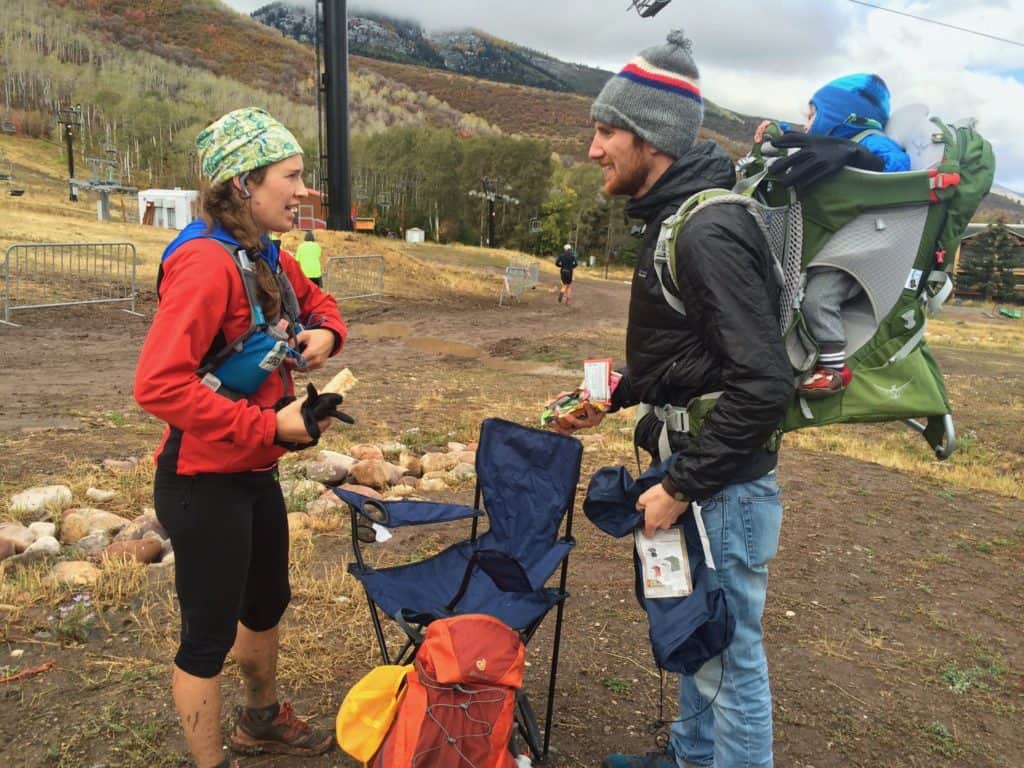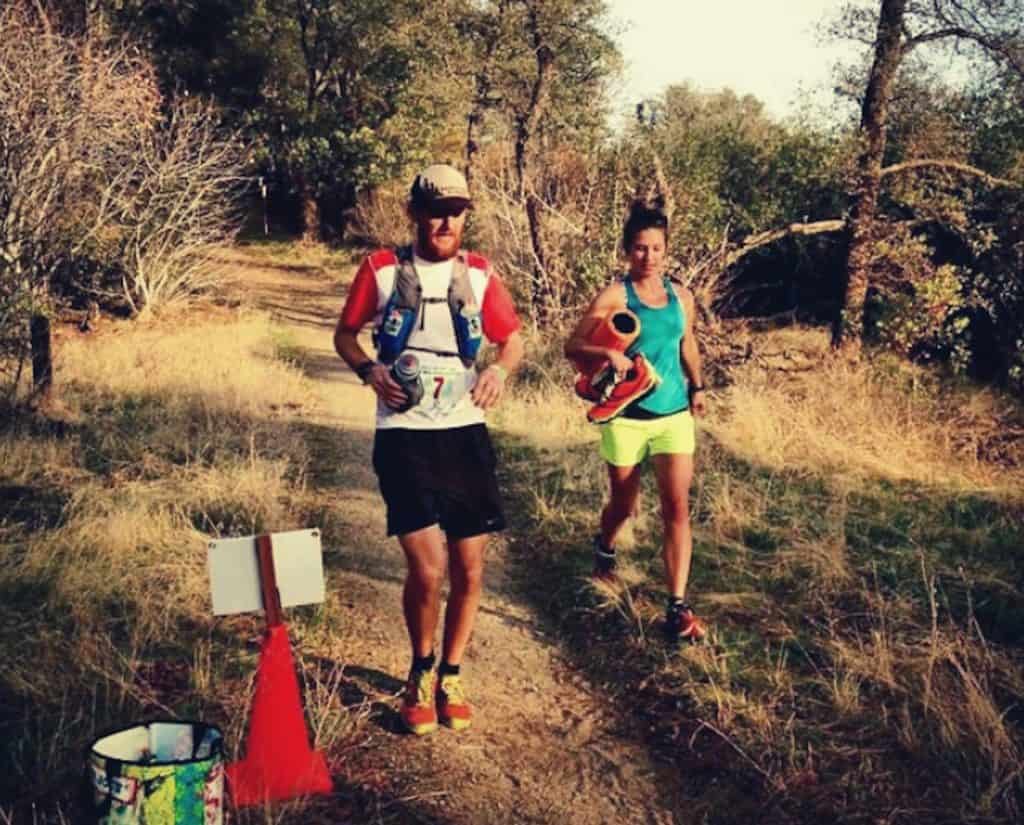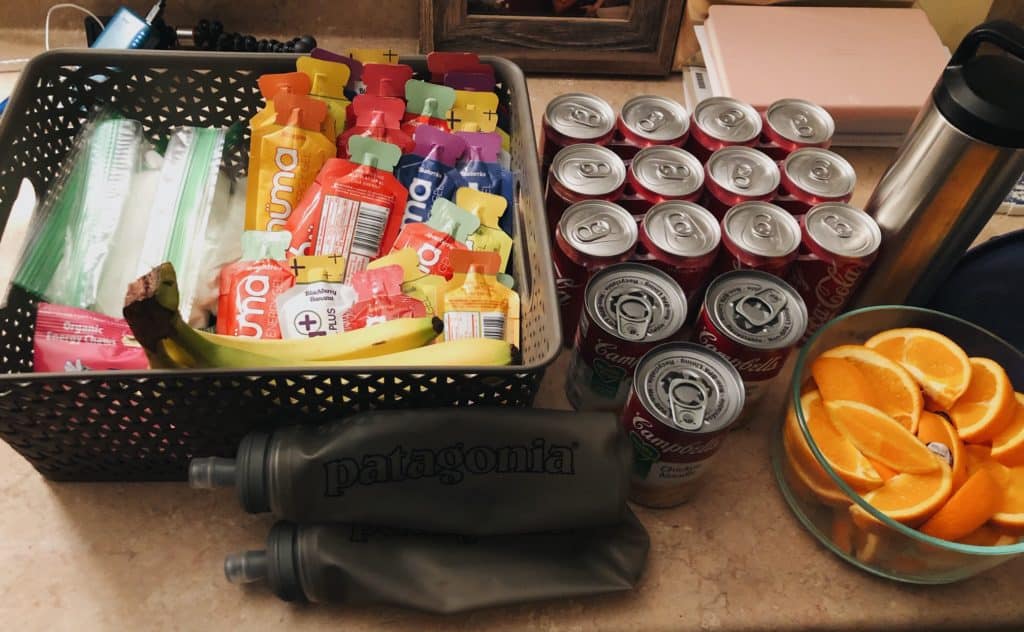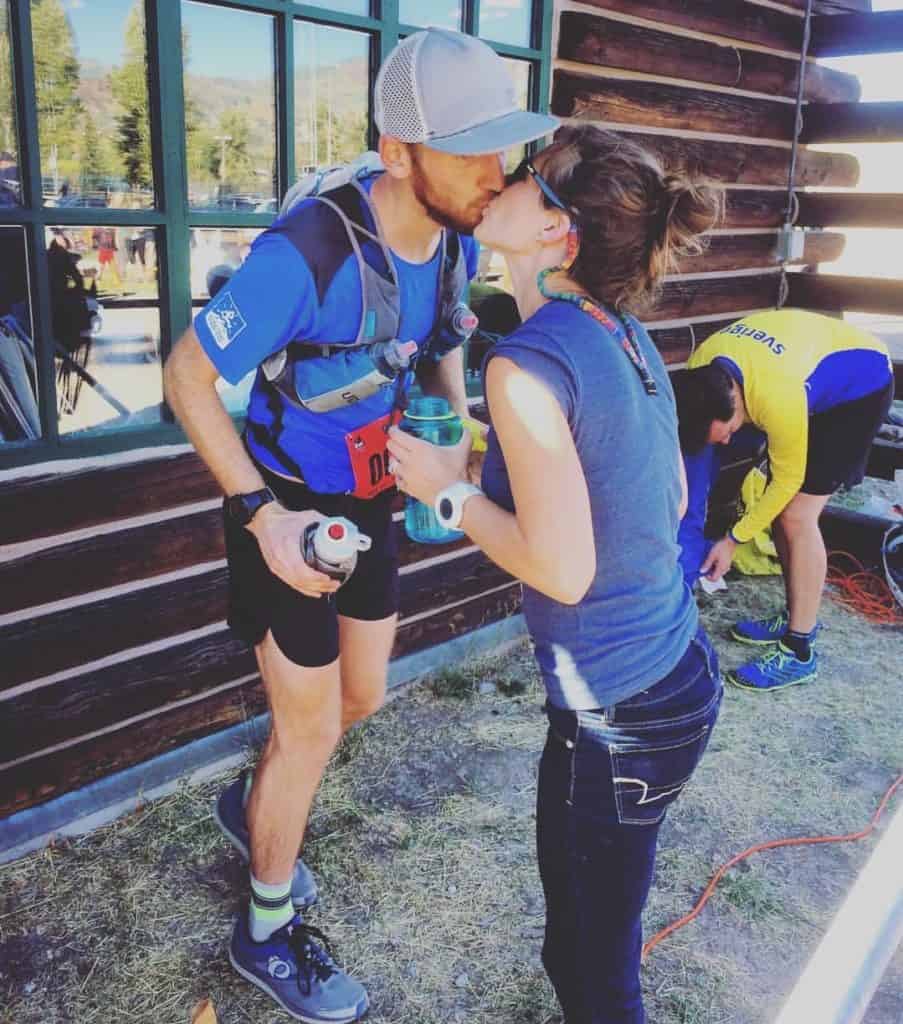So You’re Gonna be a Crew Boss.
by Nikki Parnell — November 14, 2019
I find that it’s during the winter that runners start planting seeds of “opportunity” for their friends and family to crew their ultra the following summer. If you haven’t been asked yet, the nervous voice inquiring on the other end of the line might just be coming soon. But let’s say you’ve already agreed. You’ve decided, voluntarily I might add, to sign yourself up to be a crew boss. Well done, you are a saint.
You’ve agreed to captain all the “behind the scenes” shenanigans that take place during an ultra marathon. You will be there for your runner, to support, encourage, and provide all the necessary emotional support, nutrition, gear and equipment that they might need to make their race go smoothly and efficiently. You must be their Macgyver, solving all the problems, and being their brain because most likely they aren’t going to be thinking straight. This is no small task. You are with them in this, feeling what they feel, and riding the ebbs and flows of all that a really really long run entails.

I’ve ran 50ks and 50 milers and have felt the positive effects of having a dialed in crew – mostly though, it’s the boost to my morale that means the most to me personally. I usually do pretty good scavenging aid stations for food on my own and I’m not a big shoe/sock/bra changer during a race so my crew doesn’t need to throw much at me except their smiles, cheers, and good vibes. I’ve also been on the crew side of things over 30 times, crewing my husband, Chase, in 50ks, 50 milers, 100ks, and 100 milers, so I’ve learned a few things over the years about how to crew an ultra and pull off the title of “crew boss”. Here it goes…
Do Your Own Course Research
The first and most rudimentary thing a crew boss needs to do in preparation of race day is to visit the race website and check which aid stations have crew access. Some you won’t be able to access at all per the race director’s instructions, some you can drive to but depending on the course you may need a particular type of vehicle to make it (this is why our Prius isn’t always the best crew car, but that’s okay). Some aid stations are only accessible by foot, which can make for a nice hike in the woods if you have time, or depending on the spacing between aids, it could be a good one for you to bypass. Communicate with your runner which ones are doable for you so they know where they’ll have support and where they might have to leave drop bags (bags with extra gear that the race organization will send to aid stations along the course, for when your beautiful and radiant self isn’t present).
Arrival Timeframes
Next, have a good ole chat with your runner about time ranges they’ll “expect” to come in to each aid station. If you’re crewing 100 miles, the time frame for when you need to be somewhere might be a four hour window. “Be at aid station X between 3PM and 7PM” kind of thing. A lot can happen in 100 miles, which makes the whole experience near impossible to predict. But as they are running the race you’ll get a feel for how the day is shaping up and you’ll know if they’re ahead or behind schedule. Once you have an idea of when they’ll be at certain aid stations, you can plan out what to have with you at each one (short answer: you’ll have everything with you at every aid station at all times because #justincase).
Have Everything, but Prioritize the Essentials
Here’s a test. Runner X is supposed to arrive at aid station Y an hour before sunset. Sure, have all the things, but what is most essential that you actually get your runner to take with them?

Their headlamp! And a set of backup batteries to match. You cannot run through the night without a headlamp so that’s a real game-changer. So it’s a good idea to separate the absolute essentials from all the other things that they might need. You can’t trust your runner farther than you can throw them. Again I repeat, their brains are not exactly operating at full power, so it’s up to you to make sure they get what they need.
Reminder: There’s No Reception in the Wilderness
The next thing is to screenshot all maps and directions to aid stations from the race website. The race might be in the middle of absolute nowhere and your beloved phone will be entirely useless for directions unless you have created roughly one million pictures of instructions and course maps to help you find your runner and not get lost. Some races are super easy to navigate, others not so much, and if you’re anything like me (directionally challenged and you second guess every possible turn or fork in the road) you’re gonna need your back ups. Physical topo maps should also be handy should your phone die for whatever reason. Take precautions and save yourself some stress.
List of Goods and Wares
Before the race, with your runner, pack up your crew duffle bag/bin/box/basket with all the things your runner might need (not including what they’ll already have on their body). Here’s an example of what usually makes it into ours for Chase’s races:
- Two to four extra water bottles for race vest or handhelds (fill them with water and any nutrition your runner likes to use and have them ready to quickly replace the empty bottles when your runner comes into the aid station).
- Baggies made up of Carbo Pro powder (roughly 200 calories) and half a Nuun tab (for light flavor and electrolytes). Each bag has the appropriate service size for one water bottle. We might have 20 – 30 of those bags for a 100 miler. Sounds like a lot, I know, but it might be the only thing the stomach will allow during the race, so it’s better to have too much than not enough.
- Gels. We use Huma. Might have about 30 – 40 of those too if we’re talking 100 miles.

- Head lamp (or two) and extra batteries.
- Warm layers for winter races or the inevitable cold temps at night in the mountains during a summer race (ex: base layer, puff or light jacket, shell layer, gloves, hat, running tights).
- Change of running clothes in case a piece of clothing is wet or rubbing the wrong way (I don’t think that’s ever been an issue for us, but #justincase).
- Change of socks and fresh pair of shoes. Chase never changes his shoes but some runners really like getting a pillowy boost for their feet late in a race.
- Body Glide! Because believe it or not your runner’s body parts are going to get real sick of rubbing against other body parts or clothing. I’ve seen some bad chaffage from the side-lines, enough to wonder about the possibility of one fainting down the trail due to blood loss. Only slightly kidding.
- Sunscreen. To slather them up whenever possible – they may be exposed to the hot sun for the better part of the day.
- Small foam roller if possible. Chase has ran races while having IT Band problems and has needed to roll them out during a race just to keep moving. One time when the roller wasn’t available, he had to keep jogging laps around the aid station table, waiting for volunteers to fill his water bottles, because if he stopped moving his IT Band would literally lock up!
- First aid stuff. Ibuprofen (but don’t take too much of this during the race please because your organs won’t like you) and the basics for blisters, cuts, bee stings, etc.
- Cowbell. For obvious reasons.
Hurry Up and Wait
Come race day, when your runner comes into the aid, you’ll pretty much know how they’re doing based on their body language but check in with them anyways. How are you feeling? Are you drinking enough? What do you need? How’s the stomach?
Help them grab any food they want from the incredibly well stocked aid station. It is typically a smorgasbord of delectables– chips, pretzels, M&Ms, gummy bears, potatoes, pickles, burritos, PB&Js, soup, bacon wrapped dates, gels, salt tabs, watermelon, grapes, oranges, coke, ginger ale, etc. Late in races, Chase usually sticks to orange slices, watermelon, soup and Coca Cola. It’s interesting to learn over time what foods will work for your runner and it very likely might evolve over the course of a single race.
If the race is 100 miles, your crewing experience will be one long game of hurry up and wait. There’ll be a feeling of “time is of the essence” even when you have plenty of time to catch your runner on the course. As soon as they leave one aid station, you’ll most likely pack up everything in an excited and frenzied state and jet right off to the next one a few miles down the bumpy dirt road. Part of the race fun is that you’ll see other crew members for other runners that are moving at similar paces to your runner. There is a general sense of supportive camaraderie around the similar goal of getting your runners to the finish line, which will bond you together through the day(s) as you wait at various aid stations. And you will wait… and wait and wait, all the while anxious and hoping your runner is feeling good and having the day out there that they want to be having.
Like I said before, a lot can happen in 100 miles (or any ultra distance) and it’s tough for everything to go according to plan. There will be many gnarly miles of suffering for them and their optimism and positivity will wane to say the least. But a reminder for yourself and your runner – its all temporary. Unless there is a serious injury, the low moments suck but they will pass if you just keep going. Honest. I’ve seen it happen. Somehow while running great distances, runners keep moving step by step. They might be in the pain cave at mile 60 but out of it and feeling good again at mile 70. So all is not lost if one hits a low patch! This brings me to my next point of a crew boss’s job description…
The Emotional Side of Crewing
You’re not only crewing your runner with their physical needs, you’re also crewing their emotions. The more you crew your person, the more you’ll find out how to best support and encourage them. You learn what to say and how to say it so that they’re motivated and pushed to keep going. For example, when Chase ran UTMB (100 miles around Mount Blanc, through France, Italy and Switzerland) he really wanted to quit at Champex-Lac, the mile 75 aid station. He walked in the aid station (not a good sign) and had convinced himself that he was done. It wasn’t any one thing in particular, his legs were shot, he was bonking, nauseous, and overwhelmed with the remaining distance … but he wasn’t injured, he was just experiencing a MAJOR low patch.

As his wife and the only crew member allowed in the aid station tent, I did NOT know what to say to him. It’s a fine line because I knew he would be disappointed for the days/weeks/months/years to come if he DNFed (did not finish) at UTMB. We flew half way around the world to get there and he’d even raised money from donors for a good cause with the expectation that he’d get it done. So I wanted to push him out of the tent but I also would never want him to think I wasn’t proud of him for what he had already done, a finish or no finish. It’s a delicate balance between giving positive encouragement and being accepting when things really are going to sh*t and it’s time to pull the plug. Luckily in this instance, we had Ken Sinclair. A wonderful man from Bend who was crewing another runner at the time and will always be in our personal hall of fame for saving Chase’s race experience (that sounds dramatic but I mean it). So, bottom line, Ken talks to Chase a little bit and ends up giving him a firm, “You are NOT DONE!” (he knows how hard a DNF can be on a person mentally and he didn’t want Chase to experience that at UTM-freaking-B). For whatever reason, Chase responded positively to Ken’s rallying cry. It was like Chase needed that to confirm what he already knew. That come hell or high water, he was going to get it done.
Sometimes you just can’t let your runner off the hook in those low moments. And while it feels like you are Satan’s minion in the moment, you are likely their angel in disguise because they will, with certainty, thank you later if they end up finishing. But again, it’s delicate, and you can do it wrong.
After Chase’s interaction with Ken, he turned to me and said, “Well Babe, you better go get me some soup.” I’d never been more happy to get the man some food. Boom! Back on track. Only 25 miles of brutal, mountainous trail to go, which he conquered and enjoyed, though it took him 10 more hours from the time he left that aid station. But to learn that he actually did have it in him to finish was a pretty powerful revelation for him.

If you don’t know your runner very well I would suggest talking to them about how best to lift them up when they’re low. Because what you might naturally say to them in a race may have the opposite effect, infuriate them or drive them nuts. Communication is key. Have the talk beforehand and set expectations.
Don’t Forget About Numero Uno
Please do yourself a favor and remember to take care of yourself on race day! Pack snacks, more snacks, and more snacks. I often crew with my parents or in-laws and they are always great about bringing food and they end up taking care of me while I’m trying to take care of Chase. Super helpful. When I’m by myself or crewing with the kids, I forget to eat in all the excitement and anxiety of the day (and the kids get all the snacks) so I tend to feel unnecessarily weak at the end of the race. So I’d love for you to avoid those empty feelings of malnourishment and retain your strength for after the race when, oh guess what, you’re still crewing your runner even after they’ve crossed the line.
After the race, your runner might have to spend a period of time in the depleted, fever-induced, coma-ish, slow moving (or not moving at all), state. I am NOT TALKING about Chase here … wink wink. But be ready to bring your runner weird foods they’re craving. Anything goes. I’ve gone out to get things such as cup o’ noodles, jello, whipped yogurt, pizza bites, sushi, and some electrolyte recovery fluids all in the same trip. So don’t be surprised, their bodies are just trying to replenish and their brains are telling them they need more salt and sugar! But once they get some food in them they’ll feel better and everyone can relax, share some inevitable funny stories, sleep, and enjoy the deserved accomplishment of a race well done (or not well done and that will add to the funny stories).
The Beautiful Crescendo
Generally speaking, crewing is a lively, memorable and energizing experience. It’s inspiring to watch runners do their thing – sometimes elegantly, as if it’s no big deal, other times you are eye witness to an epic struggle of will and determination. You will be awestruck by the grit and determination your runner will show.
As a crew member, you experience the full crescendo of the race. You’ve watched the giddy energy of the early morning hours, you’ve seen that energy dwindle throughout the oftentimes hot afternoon. You witness the accumulation of dirt, stink, blood and destruction. And you’ve observed the darkness and discomfort settle in as the day fades into night and the runners trudge on. But sure enough, whether in the second round of early morning hours or well into the following day, there is absolutely nothing like those moments as your runner nears the finish line. And when they do indeed cross the line, you are hit with the profound weight of what just happened. You now understand that the crazy, unpredictable, harrowing test of self that your runner just put themselves through was actually much deeper than it appeared. They were battling more than just a course, just a distance, but instead, themselves. And no matter what their actual place, they’ve just won.
You’ll learn that people are stronger than they think they are and that maybe you are too. It’s very difficult to leave an ultra uninspired. And chances are, you might want to start training, cause it’s your turn next!
And you better believe your runner will be first in line to step into the role of crew boss that you just executed with perfection.
Happy crewing.
A few people have asked us how they can support us in our work … well, here it is: Patreon allows you to give as little as $2 a month and unlock bonus content for patrons only. With your support, we are going to keep building into Treeline Journal and pitching to the world this life of endurance, passion, and freedom. If you already support us on Patreon, we cannot thank you enough.
If you enjoyed this article and want to receive all our latest articles, YouTube videos, and life updates in a conveniently packaged weekly email, sign up for our Rise & Grind Newsletter.



1 thought on “So You’re Gonna be a Crew Boss.”